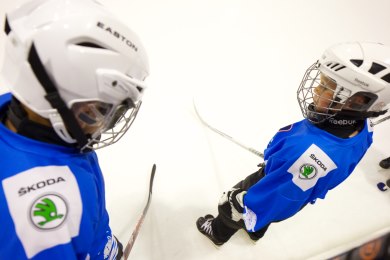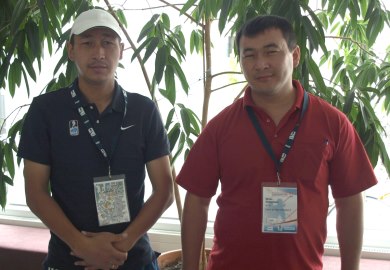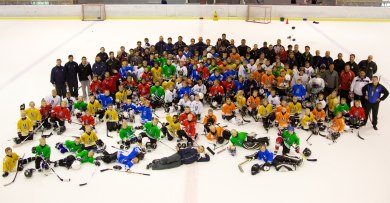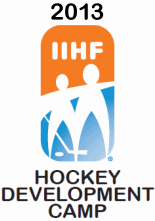VIERUMÄKI – No program assembles more coaches than the Learn to Play Program. 55 men and women from 35 countries get their education as instructors from six mentors.
This program targets instructors who teach hockey to children under the age of 10. It is split in two parts: LTP1 with the slogan “Make It Happen” with focus on recruitment, on basics and starting a program and it is followed by LTP2 with the slogan “Be World Leading” for the next age group and taking the program a step forward to make it world-class.
The Learn to Play Program is run for the tenth year while it’s the second time the LTP2 is offered.
The instructors of the two groups have had class-room sessions every day. They learn about athletes’ development, teaching skills and team play, organizing practices, recruiting players, about equipment, goalkeeper-specific coaching, how to communicate with the boys and girls and how to be a leader and mentor for the youngest players.
As we entered the room, one of the mentors, Johan Bollue from Belgium, talked about recruitment and simple measures to make their clubs known even with little or no money, such as presence and promotion at the ice rink, organizing second-hand equipment markets, having a website and preparing material for journalists.
Then a representative from Bauer, one of the manufacturers that are part of the
IIHF’s Supplier Pool, came in and had the opportunity to talk about hockey equipment, to show how to wear it correctly and to answer questions from participants, who then had the chance to have a look at the hockey gear.
“The Learn to Play Program is for training the coaches or coach leaders in different countries to run the Learn to Play Programs for young children under the age of 10,” said Kevin McLaughlin from the United States, same as Bollue one of the IIHF Development and Coaching Committee members present at the camp.
“It talks about how to structure a practice, how to run a recruitment program, how to organize coaches, practices and a season that’s very age-appropriate for kids of five- to ten-year-olds. The most important thing is to make hockey age-specific for these children.”
McLaughlin and the mentors work together with people from many nations at very different levels of hockey development.
“It’s challenging and also exciting and fun to have people from so many countries. There’s a lot of experience and knowledge from the different people where hockey is growing,” McLaughlin said.
From the class room it went to the ice, to work within the group and later during the day with daily ice sessions with 140 local kids between the age of five and ten that joined the program that’s supported by ŠKODA, the long-time official main sponsor of the IIHF Ice Hockey World Championship.
That’s when the instructors were able to practise what they’ve learned and test their skills – especially those who hadn’t had this experience before. After the sessions it went right back to the class rooms for a video session and feedback from the other students and the mentors.
 Children between the age of five and ten get hockey lessons from international students. Photo: Toni Pylvänäinen
Children between the age of five and ten get hockey lessons from international students. Photo: Toni Pylvänäinen“I like the program very much,” said Sakchai Jinanuwattana from Thailand. “I come from officiating and was in an officiating program at the camp once but this time it’s different. I’ve watched kids play many years and have knowledge as a player but now I see a different perspective from people who really know how to coach kids from the beginning.”
“Back in in Thailand, I will have a meeting with all the coaches that are interested in what I learn here because I’m the only coach participating from Thailand. I will talk to them how we can improve hockey in our country.”
Thailand is one of the newer and faster growing hockey markets in Asia. The national association climbed up the ladder in the IIHF Challenge Cup of Asia and tries to improve to one day make the World Championship program.
“We are slowly developing our hockey. We don’t have so many players but recently we had more kids playing hockey than ever before, but they usually start at six or seven,” Jinanuwattana said.
“Now we have over 100 kids under 13 or 14 years old. We have more interest than before which is good. Most kids play in the Bangkok region where we have a couple of rinks and very soon we will have some smaller ice skating sheets in the north and north-east of the country where we can have children’s and recreational hockey.”
The ambitious program in Vierumäki doesn’t give the participants too much time to check out the lakes or saunas here in Finland, but it will certainly give them a full backpack of skills and new material when they go back to their countries and help fellow instructors and become mentors themselves.
One country even had its premiere. Elzar Bolotbekov and Mirlan Dyikanbayev were the first representatives from Kyrgyzstan to take part in a Hockey Development Camp and they were split in the LTP1 and LTP2 programs.
“It’s our first experience in IIHF activities. Our country became member just two years ago and we are happy to take part in such a useful and important activity. We want to learn here as much as possible that we can spread what we learn in our republic,” said Dyikanbayev.
“Our ice hockey federation was created recently but in this short time we have reached much and won the Premier Division of the Asian Winter Games so we want to set ambitious targets for the future.”
 Elzar Bolotbekov and Mirlan Dyikanbayev are the first Kyrgyz to take part in an IIHF Hockey Development Camp. Photo: Martin Merk
Elzar Bolotbekov and Mirlan Dyikanbayev are the first Kyrgyz to take part in an IIHF Hockey Development Camp. Photo: Martin MerkAmong the instructors there are several women. Among them is Inese Geca-Miljone, who brings with her vast international experience. The 35-year-old represented Latvia in the Women’s World Championship program for the first time in 1995 and most recently last April when she played for the first time on the national team together with her daughter, Liga Miljone, who was the scoring leader of her team as a 16-year-old.
While her daughter will move to Swedish top team MODO Örnsköldsvik for next season, Inese Geca-Miljone is not sure yet whether she will continue to play next season. What she certainly knows is that she wants to help the next generation of hockey players after having played for 23 years.
“I like this program. I was here already as a coach of a girls’ team at the 2012 IIHF Hockey Development Camp,” she said. “I’m interested in the Learn to Play Program because I’m coaching boys and girls at the Hockey School Riga and I profit a lot here.”
“So many people have so much dedication to get this program going in their countries,” McLaughlin said. “Some of them translated it through their resources or universities to other languages to make it available in their own countries.”
If you want more information on the Learn to Play Program you can find resources as printable PDFs
here.
Also material of the
Recruitment Program is available for use in several languages.
“The hockey is based on the Recruitment Program and the type of entry programs they run to make kids interested and keep them interested in the sport where maybe hockey is not a traditional sport,” McLaughlin said.
“It’s about making it exciting and creating passion for the kids to play hockey. We have to compete with other sports and we want hockey to be the most fun and most attractive sport so when the kids play they get hooked.”
MARTIN MERK
 Group photo of the local children and the instructors of the IIHF Learn to Play Program at the 2013 IIHF Hockey Development Camp. Photo: Toni Pylvänäinen
Group photo of the local children and the instructors of the IIHF Learn to Play Program at the 2013 IIHF Hockey Development Camp. Photo: Toni Pylvänäinen






